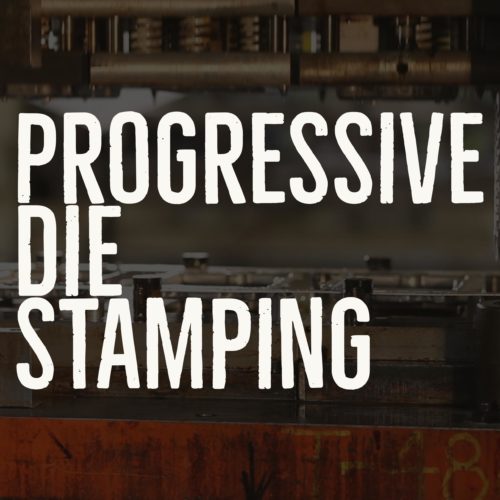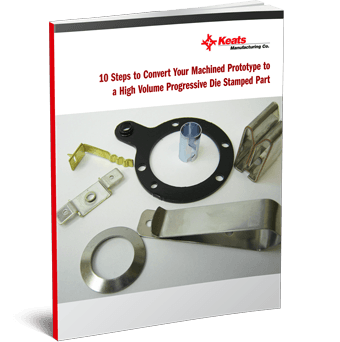One of the most popular and efficient metal stamping technologies available, progressive die stamping allows for unmatched flexibility in a wide range of applications.
 The progressive die stamping process involves the reshaping of sheet metal through a die containing individual workstations, each of which performs a different operation on the metal piece until the final component is created. The die is capable of cutting, bending, punching, coining, embossing, drawing, or shaving the metal, making it easy to customize parts to different specifications. Because this process allows multiple cutting and forming operations to be performed simultaneously, significant time and cost savings can be achieved.
The progressive die stamping process involves the reshaping of sheet metal through a die containing individual workstations, each of which performs a different operation on the metal piece until the final component is created. The die is capable of cutting, bending, punching, coining, embossing, drawing, or shaving the metal, making it easy to customize parts to different specifications. Because this process allows multiple cutting and forming operations to be performed simultaneously, significant time and cost savings can be achieved.
But accomplishing optimal synchronicity requires careful, precise design of unique dies for every metal component that will be produced. At Keats Manufacturing, we have years of experience creating progressive die designs customized to client’s specific requirements, and understand the importance of a thorough design process.
Progressive Die Stamping Design
When determining the specific construction of a progressive die with multiple stations, two major factors must be considered: 1) how complex the manufactured part will be, and 2) required production volume.
The first element to consider is the orientation of the part itself as it moves through the die. While rotating the part may be beneficial to its structure, some customers may prefer to keep it still in order to reduce the amount of wasted metal. These choices often depend on the specific end use of the part and what the client values most in their product. For example, a part for the computer industry might be rotated in the strip during stamping to prevent any inconsistencies in its shape; in this case, optimal consistency outweighs the benefits of reducing excess metal.
It’s also important to decide how the parts are carried in the strip, as this can affect how the metal feeds into the die, the machine’s ability to lift the metal into the die, and the uniformity of the products produced. Even more important, however, is deciding how the part will finally leave the die once it’s finished; this may necessitate rotating the part, switching the carrier, or even changing the order of the die’s operations. From there, one can determine the number of stations needed to perform the metal shaping itself.
The Progressive Die Manufacturing Process
After die design and construction are complete, the actual manufacturing process can begin. Extremely versatile, progressive stamping can be used for a wide range of products and can easily meet various client specifications. For example, materials ranging in size from a fraction of an inch to 2 feet wide may be used, and many different metals are well-suited to the process. Depending on the specific product, production output can be as low as 150 strokes per minute or as high as 650 strokes per minute.
Finished products can include everything from brackets, clamps, and clips to fasteners, electrical terminals, and firearm parts. The products manufactured via the progressive stamping process are used in a wide range of industries, including agriculture, automotive, computer, electrical, medical, construction, and plumbing.
Progressive Die Stamping from Keats Manufacturing
 For more than 50 years, Keats Manufacturing has been providing customers with high-quality custom small metal stampings, wire forms, and assemblies. Committed to constant innovation and improvement, we’re proud to be an ISO-certified supplier for a wide range of industries, including automotive, appliance, medical, and electronics.
For more than 50 years, Keats Manufacturing has been providing customers with high-quality custom small metal stampings, wire forms, and assemblies. Committed to constant innovation and improvement, we’re proud to be an ISO-certified supplier for a wide range of industries, including automotive, appliance, medical, and electronics.
Our team is on hand to answer any questions you may have. To learn more about the progressive stamping process and discuss how it can help keep down costs on your next project, request a quote today, or download our free e-book: 10 Steps to Convert Your Machined Prototype to a High Volume Progressive Die Stamped Part

